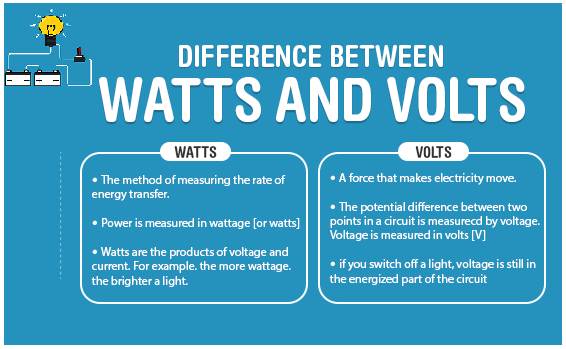Understanding the difference between watts and volts, as well as amperes (amps) and ohms, is crucial when working with any type of electrical system. Repairing household wiring requires a solid understanding of electrical terms, and it is even a helpful knowledge base to have for everyday living. How many times have you seen a lightbulb printed with “100W/120V” and wondered how the two units of electricity relate? Can the two be used interchangeably? Before looking at differences, it helps to start with basic definitions.
Watts, Volts, Amps, and Ohms Defined
Electrical terms and definitions such as watts and volts are set by a system called SI (International System of Units). An intergovernmental, international agency called BIPM (Bureau International des Poids et Mesures) sets terms and definitions for weights and measures under this system. Over a hundred countries are members or associates of BIPM.
The hydraulic (water) analogy is a common method of explaining electrical terms. Water flow within a closed-system pipe, or circuit, is compared to electrical flow. As with the closed-system pipes, electricity must move in a continuous circuit (or circular fashion) to work.
Volts
A volt represents the “potential difference between two points of a conducting wire carrying a constant current of 1 ampere when the power dissipated between these points is equal to 1 watt.” The symbol for volt is “V.”
Simplified, this means that voltage, compared to water pressure through pipes, is the speed of the electrons as they pass a point within the circuit.
Amps
With amps (short for amperes), the SI official definition is not only unwieldy but ever-changing. Its general thrust, though, never changes. Amps are the base unit that measure the volume of the electrons in the electrical circuit. The letter “A” capitalized is the symbol for amperes or amps.
With the hydraulic comparison, amps would be a unit of measure indicating the volume of water moving past a certain point. Volume is quantity, not speed. A lightning strike is about 20,000 amps. A watch may draw one-millionth of an amp. Household electrical cables typically are rated for 15 amps or 20 amps.
Watts
A watt expresses the rate of power flow. When one amp flows through an electrical difference of one volt, its result is expressed in terms of watts. “W” is the symbol for watt or watts.
Watts are derived from the formula V x A = W.
Ohms
The base unit ohm is the SI term indicating electrical resistance. Ohm is a measurement of the resistance that a device or material placed within the electrical circuit resists or reduces the electrical flow. The Greek symbol for omega, resembling a downward horseshoe, is also the symbol that denotes ohms.
The Difference Between Watts and Volts

Watts and volts are not independent of each other. Watts cannot exist without volts since they are the product of a combination of volts and amps. In basic terms and using the hydraulic analogy, volts are similar to pressure and watts are similar to rate.
Understanding the concept of rate is key to understanding watts vs. volts. When traveling in a car, it is possible to say that the vehicle covered 65 miles. While this is useful information, it doesn’t give us a good picture of exactly what just happened. Did the car do those 65 miles in one hour, as one might reasonably expect, or did it take three months to cover that distance?
Or if you were to tell a friend that you drove for ten hours, she might follow up by asking where you drove or how far you drove. Discussing the length of a car trip is far less meaningful than if you said that you covered 800 miles during those ten hours.
One set of data deals with distance in the physical world; another set deals with time. Instead of juggling two sets of data back and forth, it is much more helpful and convenient to come up with a single number that combines the two. That number is rate.
So, the formula V x A = W is similar to the car trip example; both indicate rate. With the car, that rate is the familiar designation MPH (miles per hour): rate is equal to distance divided by time.
In electrical systems, amperage and voltage are useful sets of information. But wattage is an additional usual body of data because it combines the two to produce an indicator similar to rate or speed.

